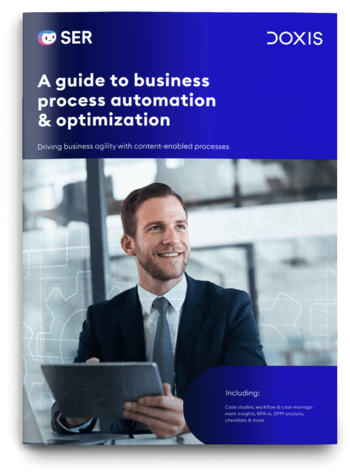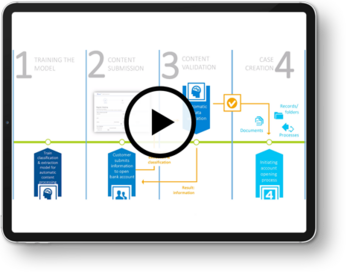SER Blog Innovation & Technology
7 information management trends for the new digital workplace of 2021
In 2020, digital transformation was pushed to the forefront for companies, if it hadn’t been there already. Fast-tracked by the pandemic, remote work went from an ad hoc solution in 2020 to a fact of business working life in 2021. Now, companies are designing hybrid remote/office work scenarios and seeking ways to facilitate what Gartner calls “anywhere operations”. In fact, 50% of companies are currently investing in making remote work possible for even more employees in the future. The impact of this trend has had immense consequences on how companies and their employees store, find, manage, collaborate on, process and utilize information. New challenges have arisen concerning collaboration, workflows, information access, security and much more. Many will persist in 2021.

Business leaders have to answer some hard questions: How can they speed up digitalization initiatives without sacrificing quality and value? Which digital solutions can increase flexibility, create more cost-effective operations, improve planning capabilities, and boost agility? How can you make daily (remote) work easier and faster for employees, but also prevent information silos and meet compliance and governance requirements? How can you make processes smarter and more efficient through automation and AI?
It’s time to take the challenges of 2020 and turn them into opportunities for growth and learning. There is no returning to how things done were before. Business leaders need pragmatic, extendible digital solutions in 2021 that employees love to use, solve current and future challenges, and have a tangible return on investment. To help achieve this in 2021, here are 7 information management trends for the new digital workplace:
1. Incremental automation
Automation is and will remain a key trend for businesses seeking e.g. to free up employees from time-consuming tasks, create leaner, more transparent and faster processes, and replace expensive and complex legacy business processes. Hyperautomation, i.e. automating anything that can be automated, might be trending lately – but the feasibility of full-scale automation is probably overwhelming to companies emerging from a tough financial period. They may not have the budgets or capacities for such sweeping projects.
Rather, we anticipate in 2021 a trend towards pragmatic, incremental automation. Companies are now evaluating which workflows or process steps can be automated relatively quickly and have a positive impact both on employee productivity and costs. For example, a solution that integrates content with automated processes and LOB applications can provide some practical relief in daily operations. This could take many forms, but here are some common use cases:
• Automated contract or budget approval workflows
• Automated employee on/offboarding processes
• Automated invoice verification
• Automated inbound mail processing
The bottom line: Automation will continue to be a crucial tool for companies – but in this recovery period, it’s more likely that incremental improvements to processes and workflows will have the necessary positive impact to drive digitalization quickly and solve urgent issues first.

Business process automation & optimization guide
How can you digitize, automate & streamline your business processes for greater agility, customer experience & operational efficiency? Our in-depth guide provides actionable recommendations, case studies & checklists to help you achieve process digitalization. Read now ⯈
Read now2. Customizable intelligence
Have you noticed how everything is intelligent nowadays? It’s not just marketing – AI is an applicable option in everyday business operations. Back in our trends analysis for 2019, we already talked about how a content services platform creates the foundation for using AI technologies. And we have observed how our customers benefit from this: they have excellent data sets, because information is organized and readily accessible, content is labeled with metadata, and data is fully accounted for. This opens up new levels of independence, transparency and accuracy, which, in 2021, we anticipate will lead to the emergence of customizable intelligence. While external data is good for many use cases, companies have recognized that it can lead to faulty results and lacks traceability. They might want the option instead to base their machine learning sets not on external training data, but on their own high-quality data, customized to their business.
A use case for customizable intelligence can be found in highly regulated sectors. In the banking and financial market, for example, when new and tougher regulations are enforced for the retention and management of data, this has the potential to tie up personnel for months. Case in point: A customer recently approached us to help them find a way to analyze loan agreements and store a set of metadata for each one – as stipulated by new regulations. Without the use of content analytics and extraction, this would have been a very costly endeavor and, frankly, impossible for the team to complete within the given timeframe. Because this customer already has a content services platform in place, it is able to base the content extraction on its own data sets – ensuring higher quality results and no external influence. Customizable intelligence can be applied in many other ways: to flag customer complaints sent via email using sentiment analysis; to automatically read and verify the content of an invoice to detect and correct errors quickly; to automatically forward a case inquiry to the right caseworker using named entity recognition (NER); and many more.

Intelligent and streamlined banking with Doxis Cognitive Services
This video demonstrates how intelligent content processing using classification and extraction can streamline and boost the efficiency of banking processes to benefit customers, employees and the entire business.
Watch now3. Quick & pragmatic digital solutions
Agility, flexibility and resilience are the qualities that companies will need most in 2021 as they seek ways to recover not just quickly, but also sustainably. The same applies to information management, which is why we foresee pragmatic, modular and extendible digital solutions becoming more important for companies with tight post-pandemic budgets who nevertheless urgently need to push digitalization. We have already observed a rise in demand for quick and pragmatic solutions to facilitate secure, efficient and mobile content and process management. This is achieved in a couple of ways. For one, there are ready-to-launch solutions for specific use cases. For example, a digital HR solution can be immediately deployed to give your HR team a means of collaborating on and securely managing employee data – even in compliance with the EU GDPR – while working remotely.
The other way to accelerate digitalization and enhance agility in your information management is through low-code, no-code development environments, which allow your own teams to create and adapt apps and workflows much faster than traditional software projects. This is crucial when, for example, your team needs to quickly adjust processes or workflows to meet changing customer or market requirements. As they are the ones who know best and fastest what they need, it makes sense that the users have the option to customize the configurations, rights, design and more to meet their immediate requirements.
4. Cloud? Yes, but with options
Fortunately for companies today, they have the option of running their solutions in the cloud. When considering the cloud or other deployment scenarios in 2021, however, companies should assess their current challenges, what they need to achieve, the level of flexibility and stability needed, and which model will help them achieve this. For example, do you want to run your applications in the cloud, but you also need a local, on-premises storage system at dedicated locations? Local storage means you can cache documents and they are available immediately. This is an important option for companies that work with extremely large files (e.g. CAD files in construction) that are huge and slow to load. A local drive might suit their purposes better and provide them the necessary speed and availability to keep operations running smoothly. While cloud is ubiquitous now and will remain so in the future, it’s not always the perfect solution. Depending on the nature of your work and data, a hybrid of cloud and on-prem is sometimes faster and can solve data security requirements and issues, particularly in terms of intellectual property and personal identifiable information.
5. Ensuring information governance & security – also remotely
Gaps in information governance, compliance and security policies became painfully clear for many companies in 2020. With the majority of employees working from home, it was suddenly not possible in some cases to handle data in compliance with privacy and protection laws. Furthermore, without a secure content collaboration solution, many were unable to store and work on documents in accordance with corporate policies. The use of shadow IT or inadequate digital solutions during the pandemic exposed many companies to all new risks, such as the loss of intellectual property or confidential information. The stakes for information mismanagement have already been raised over the past 5 years due to security breaches¹ – which have likewise increased the need for an information governance policy.
As 2021 starts, the challenges are piling up: increasing regulations, enabling secure and compliant collaboration internally and externally, managing information sprawl, and finding ways to solve these risk issues in a cost-effective way – just to name a few. Leveraging digitalization solutions in information governance and compliance will be a key trend in 2021. A content services platform with collaboration capabilities provides the essential foundation: a secure corporate repository that supports records management, compliance, security and privacy. To facilitate ‘operations anywhere’, companies need a solution that enables access to all content, processes and data through one system (federation).
6. Connected business ecosystems
When Gartner coined the term ‘new work nucleus’ in 2019², describing the transition to a modern digital workplace based on content collaboration, cloud and productivity tools, little did they know that a global pandemic would give these tools a whole new degree of urgency. In the new work nucleus of 2021, we believe it will become even more essential for companies to connect their business ecosystems to provide a way for employees to retrieve and work with content in a modern, seamless way across devices and organizational boundaries. In other words, companies will seek platforms to establish networks of technologies, applications and services. This can be achieved with a content services platform that provides a broad range of integration possibilities/prebuilt connectors. Common new work nucleus connectors, as Gartner identifies in the 2020 Critical Capabilities for Content Services Platforms report, create a bridge to collaboration tools like Microsoft Teams, Google Workplace and Slack. But integration with LOB applications like SAP and Salesforce are equally critical to ensure an interconnected ecosystem for business continuity, excellent customer experience, and agility. A secure content services platform can federate content from diverse sources for immediate access and traceability. A connected ecosystem also makes daily work easier for employees, as they use fewer tools to find and work with information.
7. Take care of your people!
The unfortunate by-products of remote work have been excessive overtime, a lack of personal interactions, emotional disconnection, the strain of countless Zoom meetings, individual work instead of teamwork – and, yes, burnout. Productivity has gone through the roof at many companies, even though many are juggling the stress of homeschooling and child care with work. The time saved from commuting is often being invested into increased output. In companies' efforts to find tools and solutions for a more effective, higher performing digital (remote) workplace, in 2021 they will also (have to) explore ways to prevent remote burnout and protect their employees. Behind all of the information management trends talked about here, there is always one common denominator: people. In the end, it always has to be about finding ways to make your employees’ daily work easier, faster, less stressful and more convenient. Here at the SER Group, we make solutions for people. Tech trends come and go, but people remain – so let’s take care of them.
¹ “Accessible AND Secure – Best Practices for Automating Information Governance,” AIIM Industry Watch Research, 2019
² “Create a Culture of Digital Dexterity With the ‘New Work Nucleus’,” by Mike Gotta, Matthew Cain, 20 May 2019

Maureen Cueppers
Hello there! My name is Maureen Cueppers and I’m the Head of Content & Communications at SER. Analyzing, breaking down and clearly explaining the trends & possibilities of intelligent content automation for our readers – this is always at the heart of my writing. A native of Oregon (USA), I’m a craft beer enthusiast and have 43 nicknames (the last time I counted).
The latest digitization trends, laws and guidelines, and helpful tips straight to your inbox: Subscribe to our newsletter.
How can we help you?
+49 (0) 30 498582-0Your message has reached us!
We appreciate your interest and will get back to you shortly.




